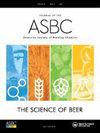Determination of Hop Aroma Compounds in Beer Using Headspace-Solid Phase Microextraction Coupled with Gas Chromatography and Mass Spectrometry (HS/SPME/GC/MS)
IF 1.8
4区 农林科学
Q4 BIOTECHNOLOGY & APPLIED MICROBIOLOGY
Journal of the American Society of Brewing Chemists
Pub Date : 2023-02-17
DOI:10.1080/03610470.2023.2165387
引用次数: 0
Abstract
Abstract Hop aroma compounds, such as β-myrcene, linalool, and geraniol, play a very important role as indexes for beer flavor and process control. However, since they comprise many compounds with different physical properties and their concentration in beer is low, their simultaneous analysis has been a difficult task in the past, resulting in no method being proposed for inclusion in the Methods of Analysis of BCOJ. We propose a method for simultaneously analyzing the low-concentration compounds in beer using HS/SPME/GC/MS as one of the potential Methods of Analysis of BCOJ and evaluated its concurrent accuracy and inter-room repeatability and reproducibility. The collaborative work was conducted in 12 laboratories in Japan. The statistical summary of results is as follows: The relative standard deviation of repeatability (RSDr) ranged from 4.8 to 20.3% for β-myrcene, 3.7 to 5.2% for linalool, and 5.7 to 9.6% for geraniol; and the repeatability at 95% probability (r95) ranged from 1.5 to 15.3 µg/L for β-myrcene, 2.7 to 6.2 µg/L for linalool, and 0.7 to 2.1 µg/L for geraniol. The relative standard deviation of reproducibility (RSDR) ranged from 11.0 to 41.2% for β-myrcene, 8.1 to 11.6% for linalool, and 12.7 to 25.8% for geraniol; and the reproducibility at 95% probability (R95) ranged from 3.4 to 22.8 µg/L for β-myrcene, 5.6 to 15.6 µg/L for linalool, and 2.7 to 4.3 µg/L for geraniol. The obtained results were deemed acceptable. It was concluded that the method can determine hop aroma compounds in beer, low-malt beer, and third-category beer.顶空-固相微萃取-气相色谱-质谱联用(HS/SPME/GC/MS)测定啤酒中啤酒花香气成分
摘要酒花香气化合物β-月桂烯、芳樟醇和香叶醇是啤酒风味和工艺控制的重要指标。然而,由于它们包含许多具有不同物理性质的化合物,并且它们在啤酒中的浓度很低,因此它们的同时分析在过去一直是一项困难的任务,导致没有提出将方法纳入BCOJ的分析方法。本文提出了一种利用HS/SPME/GC/MS同时分析啤酒中低浓度化合物的方法,作为啤酒中BCOJ的潜在分析方法之一,并评价了该方法的同时准确度、室内重复性和再现性。这项合作工作是在日本的12个实验室进行的。结果统计总结如下:β-月桂烯的重复性相对标准偏差(RSDr)为4.8 ~ 20.3%,芳樟醇为3.7 ~ 5.2%,香叶醇为5.7 ~ 9.6%;β-月桂烯的重复性为1.5 ~ 15.3µg/L,芳樟醇为2.7 ~ 6.2µg/L,香叶醇为0.7 ~ 2.1µg/L,重复性为95% (r95)。β-月桂烯的相对标准偏差(RSDR)为11.0 ~ 41.2%,芳樟醇为8.1 ~ 11.6%,香叶醇为12.7 ~ 25.8%;β-月桂烯的重复性为3.4 ~ 22.8µg/L,芳樟醇的重复性为5.6 ~ 15.6µg/L,香叶醇的重复性为2.7 ~ 4.3µg/L。得到的结果被认为是可以接受的。结果表明,该方法可用于啤酒、低麦芽啤酒和三类啤酒中酒花香气成分的测定。
本文章由计算机程序翻译,如有差异,请以英文原文为准。
求助全文
约1分钟内获得全文
求助全文
来源期刊

Journal of the American Society of Brewing Chemists
工程技术-生物工程与应用微生物
CiteScore
4.00
自引率
20.00%
发文量
41
审稿时长
3 months
期刊介绍:
The Journal of the American Society of Brewing Chemists publishes scientific papers, review articles, and technical reports pertaining to the chemistry, microbiology, and technology of brewing and distilling, as well as the analytical techniques used in the malting, brewing, and distilling industries.
 求助内容:
求助内容: 应助结果提醒方式:
应助结果提醒方式:


